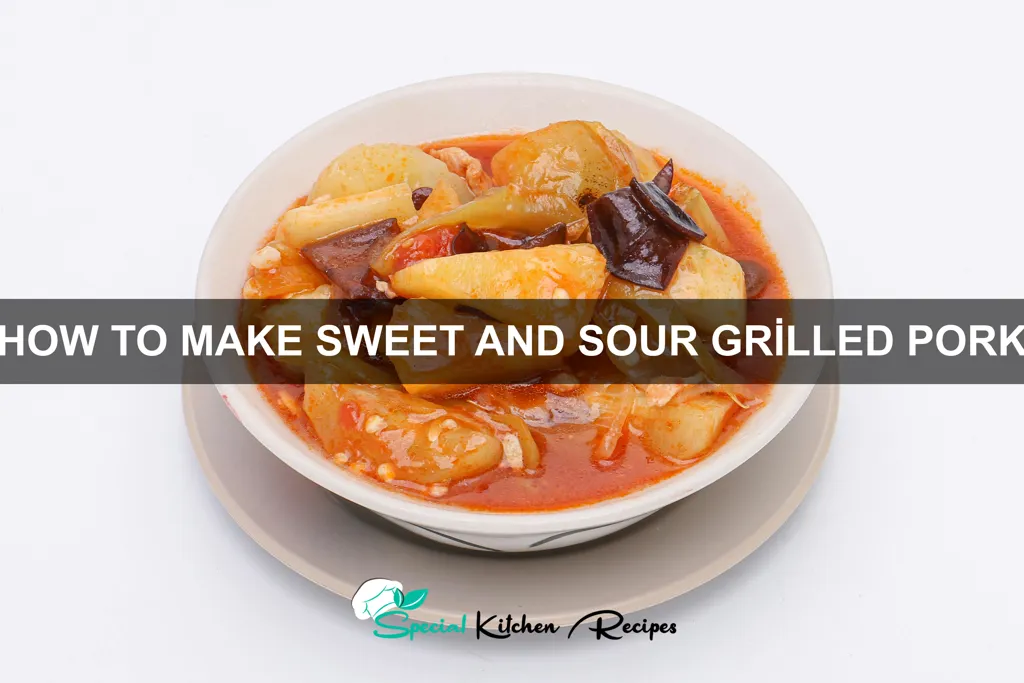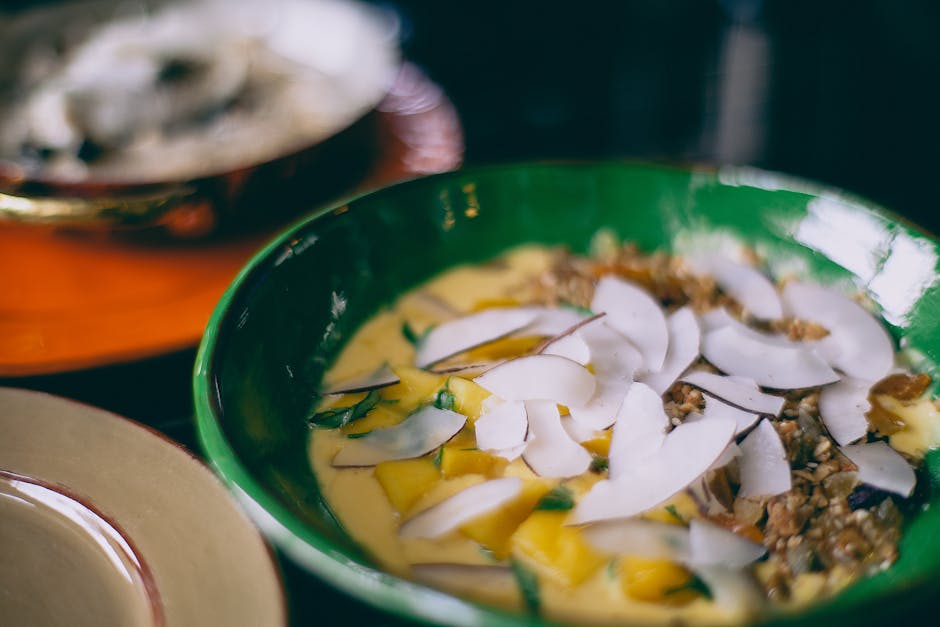Sweet and sour grilled pork, a dish that tantalizes taste buds with its delightful balance of tangy and sugary flavors, boasts a rich and fascinating history. While pinpointing its exact origin is difficult, its roots likely lie in the culinary traditions of Southeast Asia, particularly China. The combination of sweet and sour profiles is a hallmark of many Asian cuisines, reflecting the region’s abundant use of fruits, vinegars, and spices. Recipes varied greatly across different regions, depending on available ingredients and local preferences. Some historians suggest that early versions may have involved grilling meats over open fires, utilizing simple preparations of readily available fruits like tamarind or mangoes to create the sweet and sour sauce.
The dish’s popularity spread globally through trade and migration, evolving into countless variations. Chinese immigrants, for example, played a significant role in introducing sweet and sour preparations to other parts of the world, including the West. In the United States, sweet and sour pork became a staple of Chinese-American cuisine, often served in restaurants across the country. According to a 2021 survey, sweet and sour dishes rank among the top five most popular takeout choices in the US, highlighting the enduring appeal of this flavor combination. This demonstrates the dish’s incredible adaptability and its capacity to transcend cultural boundaries.
The cultural significance of sweet and sour grilled pork, or its variations, is undeniable. In many cultures, meat cooked in a sweet and sour sauce often represents festive occasions or special celebrations. The vibrant colors and complex flavors symbolize abundance and prosperity. The balance between sweet and sour itself can be viewed as symbolic of life’s complexities—a harmony of contrasting elements. Moreover, grilling the pork adds a smoky depth that enhances the overall experience, reflecting a primal connection to fire and cooking techniques passed down through generations. The method of preparation can also vary, from simple home-style grilling to more elaborate restaurant versions, reflecting the diverse culinary traditions that have shaped this beloved dish.
Ingredients and Measurements
This recipe yields approximately 4 servings of delicious sweet and sour grilled pork. Accurate measurements are crucial for achieving the perfect balance of flavors, so please use a kitchen scale for the most precise results. Alternatively, use measuring cups and spoons, ensuring you level off each ingredient.
For the Pork Marinade:
- 1.5 lbs (680g) boneless pork loin, cut into 1-inch thick slices. Choose a lean cut for optimal grilling and to avoid excessive fat dripping onto the grill.
- 1/4 cup (60ml) soy sauce (low sodium preferred). Using low-sodium soy sauce allows you to better control the saltiness of the dish.
- 2 tablespoons rice vinegar. This adds a subtle tanginess that complements the sweetness.
- 1 tablespoon brown sugar. Pack the brown sugar lightly for accurate measurement.
- 1 tablespoon honey. Honey adds a deeper sweetness and moisture to the marinade.
- 1 teaspoon ground ginger. Freshly grated ginger would be even better for a more intense flavor.
- 1 teaspoon garlic powder. Alternatively, use 2 cloves of minced fresh garlic for a more pungent flavor.
- 1/2 teaspoon black pepper.
For the Sweet and Sour Sauce:
- 1/2 cup (120ml) ketchup. Use a high-quality ketchup for the best flavor.
- 1/4 cup (60ml) pineapple juice (from canned pineapple is fine). This adds both sweetness and acidity.
- 2 tablespoons rice vinegar.
- 2 tablespoons brown sugar.
- 1 tablespoon soy sauce (low sodium).
- 1 tablespoon cornstarch.
- 1/2 teaspoon ground ginger.
- 1/4 teaspoon red pepper flakes (optional, for a touch of heat).
For Serving (Optional):
- Sesame seeds for garnish.
- Chopped green onions for garnish.
- Cooked rice to serve alongside.
Important Note: Allow the pork to marinate for at least 30 minutes, or preferably 2-4 hours in the refrigerator for maximum flavor penetration. The longer it marinates, the more tender and flavorful your grilled pork will be. Remember to bring the marinated pork to room temperature before grilling for even cooking.
Marinade Preparation
The success of sweet and sour grilled pork hinges significantly on the marinade. A well-balanced marinade will tenderize the pork, infuse it with flavor, and create a beautiful caramelization on the grill. This recipe calls for a vibrant and flavorful marinade that balances sweet, sour, savory, and a touch of spice.
To begin, we’ll need the following ingredients: 1 cup soy sauce (low sodium preferred), ½ cup apple cider vinegar, ¼ cup honey, ¼ cup brown sugar, 2 tablespoons rice wine vinegar, 1 tablespoon grated fresh ginger, 2 cloves garlic, minced, 1 teaspoon ground white pepper, and ½ teaspoon red pepper flakes (optional, for a touch of heat). Accurate measurements are key for achieving the perfect balance of flavors.
In a medium-sized bowl, whisk together the soy sauce, apple cider vinegar, honey, and brown sugar until the sugars are completely dissolved. Ensure the sugars are fully dissolved to prevent crystallization on the meat during grilling. This is a crucial step for a smooth, even marinade.
Next, add the rice wine vinegar, which adds another layer of complexity and brightness to the marinade. Then, incorporate the grated ginger and minced garlic. Freshly grated ginger and minced garlic provide the most vibrant flavor; pre-ground versions lack the same potency.
Finally, stir in the ground white pepper and red pepper flakes (if using). The white pepper offers a subtle warmth without overpowering the other flavors, while the red pepper flakes add a pleasant kick. Taste the marinade and adjust seasonings as needed. You might want to add a touch more honey for extra sweetness or vinegar for more tang, depending on your preference.
Once the marinade is prepared, pour it into a resealable bag or a shallow dish, ensuring the pork is fully submerged. For optimal flavor penetration, marinate the pork for at least 4 hours, preferably overnight in the refrigerator. The longer marinating time allows the flavors to deeply penetrate the meat, resulting in incredibly tender and flavorful grilled pork.
Before grilling, remove the pork from the marinade and discard the used marinade. Never reuse marinade that has been in contact with raw meat due to food safety concerns. Pat the pork dry with paper towels to help achieve a good sear on the grill.
Pork Preparation and Marinating
Selecting the right cut of pork is crucial for achieving tender and flavorful grilled sweet and sour pork. We recommend using pork shoulder, also known as Boston butt, or a boneless pork loin. These cuts are relatively lean yet possess enough fat to remain juicy during grilling. Avoid overly lean cuts, as they can dry out easily.
Begin by trimming away any excess fat from the pork. While some fat is beneficial, excessive fat can lead to flare-ups on the grill and an overly greasy final product. Aim for a layer of fat no thicker than about ¼ inch. Once trimmed, cut the pork into 1 ½ – 2 inch cubes. Consistency in size is important for even cooking; ensure all pieces are roughly the same dimensions.
Now, let’s create the marinade. This is where the magic happens! For approximately 2 lbs of pork cubes, you will need: ½ cup soy sauce (low sodium is preferred), ¼ cup rice vinegar, ¼ cup honey or brown sugar, 2 tablespoons grated fresh ginger, 2 cloves garlic (minced), 1 tablespoon cornstarch, 1 teaspoon sesame oil, and ½ teaspoon black pepper. Adjust the sweetness to your preference by increasing or decreasing the honey/brown sugar.
In a large bowl, whisk together all the marinade ingredients until the sugar or honey is fully dissolved. Add the cubed pork, ensuring all pieces are thoroughly coated in the marinade. Cover the bowl with plastic wrap and refrigerate for at least 4 hours, or preferably overnight. The longer the pork marinates, the more flavorful and tender it will become. The marinade will also help to tenderize the meat and prevent it from drying out on the grill.
Before grilling, remove the pork from the marinade and let it sit at room temperature for about 15-20 minutes. This allows the meat to come to a more consistent temperature, resulting in more even cooking. Reserve the marinade; do not use it on the grill, as it contains raw meat juices. Dispose of the used marinade appropriately.
Remember to always handle raw pork safely. Wash your hands thoroughly before and after handling the meat, and use separate cutting boards and utensils for raw and cooked pork to prevent cross-contamination.
Grilling the Pork
Once your pork is marinated (following the marinating instructions in the previous section), it’s time to fire up the grill! For this recipe, we recommend using a charcoal grill for that smoky flavor, but a gas grill will work just as well. Preheat your grill to medium-high heat (approximately 375-400°F or 190-205°C). You should be able to hold your hand about 6 inches above the grates for 4-5 seconds before needing to pull it away – this indicates the ideal temperature.
Lightly oil the grill grates to prevent sticking. This is crucial for achieving those beautiful grill marks and ensuring easy removal of the pork. You can use a high-heat cooking spray or a paper towel dipped in vegetable oil. Avoid using too much oil, as this can cause flare-ups.
Place the marinated pork chops (approximately 1-inch thick) onto the preheated grill grates. Avoid overcrowding the grill; leave some space between each chop for even cooking. If necessary, grill in batches to ensure proper heat distribution.
Grill the pork chops for approximately 4-5 minutes per side for medium-rare, or until the internal temperature reaches 145°F (63°C) for medium. Use a meat thermometer to ensure accuracy – this is the most reliable way to guarantee the pork is cooked safely and to your desired doneness. Thicker chops will require longer grilling time; adjust accordingly.
For extra flavor, you can baste the pork chops with the remaining marinade during the last few minutes of grilling. Be careful not to baste with a marinade that has come into contact with raw meat, to avoid cross-contamination. Instead, use a fresh batch of the marinade, or just use a simple glaze of your choice.
Once the pork chops reach the desired internal temperature, remove them from the grill and let them rest for 5-7 minutes before slicing and serving. This resting period allows the juices to redistribute, resulting in a more tender and flavorful final product. Resting the meat is just as crucial as the grilling process itself.
Serve immediately with your favorite sweet and sour sauce. Enjoy your delicious Sweet and Sour Grilled Pork!
Sweet and Sour Sauce Preparation
The success of your sweet and sour grilled pork hinges significantly on the quality of your sauce. This recipe delivers a perfectly balanced sweet and sour flavor profile, complementing the savory pork beautifully. We’ll be making a homemade sauce, which allows for greater control over sweetness, tanginess, and consistency.
Ingredients:
- 1 cup white vinegar (5% acidity is ideal)
- 1 cup granulated sugar
- 1/2 cup ketchup (for body and umami)
- 1/4 cup pineapple juice (adds sweetness and fruity notes)
- 2 tablespoons soy sauce (for saltiness and depth of flavor)
- 1 tablespoon cornstarch
- 1 teaspoon grated ginger (freshly grated is best)
- 1/2 teaspoon garlic powder
- 1/4 teaspoon red pepper flakes (optional, for a touch of heat)
Instructions:
In a medium saucepan, combine the vinegar, sugar, ketchup, pineapple juice, soy sauce, ginger, garlic powder, and red pepper flakes (if using). Stir well to ensure the sugar dissolves completely. This step is crucial to prevent a grainy sauce. Bring the mixture to a gentle simmer over medium heat, stirring occasionally.
In a small bowl, whisk together the cornstarch with 2 tablespoons of cold water until a smooth slurry forms. Avoid lumps by whisking vigorously. This creates a smooth, thickened sauce.
Slowly pour the cornstarch slurry into the simmering sauce, whisking continuously to prevent clumping. Continue whisking until the sauce thickens to your desired consistency, about 1-2 minutes. It should coat the back of a spoon smoothly. If it becomes too thick, add a tablespoon or two of water to thin it out.
Remove the sauce from the heat and let it cool slightly before using. This allows the flavors to meld together and the sauce to thicken further. The sauce can be made ahead of time and stored in the refrigerator for up to 3 days.
Professional Recommendation: For a richer, more complex flavor, consider substituting a portion of the white vinegar with rice vinegar. Experiment with different types of ketchup – some have a sweeter profile than others – to adjust the sweetness to your preference. Finally, remember to taste and adjust seasoning as needed before serving. A pinch of salt or a squeeze of lime juice can elevate the flavor profile.
Combining Pork and Sauce
Once your pork is perfectly grilled, the magic truly begins: marrying the smoky char with the vibrant sweet and sour sauce. This step is crucial for achieving that perfect balance of flavors and textures. We’ll be using approximately 1 ½ cups of your prepared sweet and sour sauce (recipe should be detailed elsewhere in the guide). Ensure your sauce is warm, but not boiling; a gently simmering sauce will coat the pork more effectively without cooking it further.
To begin, remove the grilled pork from the grill and let it rest for about 5-7 minutes. This resting period allows the juices to redistribute, resulting in a more tender and flavorful final product. While the pork rests, you can prepare your serving dish. A large, shallow dish is ideal for ensuring even sauce coverage.
Carefully transfer the grilled pork to the prepared dish. If you’ve cut the pork into smaller pieces prior to grilling, this is straightforward. If you’ve grilled larger cuts, now’s the time to slice them into bite-sized pieces, ensuring even distribution of the sauce. Avoid overcrowding the dish; this will prevent the sauce from coating the pork evenly.
Now, gently pour the warm sweet and sour sauce over the pork. Using tongs or two forks, carefully toss the pork to ensure every piece is thoroughly coated in the sauce. Work gently to avoid breaking the pork, especially if you’ve used a leaner cut. Don’t rush this process; it’s better to take your time and ensure complete coverage than to end up with some dry pieces.
Once the pork is evenly coated, you have the option to gently simmer the pork in the sauce for a few minutes over low heat. This will allow the flavors to meld even further, creating a richer, more complex taste. However, it is crucial to monitor the pork closely to prevent overcooking and drying out. A minute or two should be sufficient. If you choose to skip this step, that’s perfectly fine; the sauce will still provide ample flavor.
Finally, serve immediately. The sweet and sour grilled pork is best enjoyed while still warm, allowing you to appreciate the full spectrum of flavors and the perfect balance of sweet, sour, and smoky notes. Garnish with chopped green onions or sesame seeds for an extra touch of visual appeal and flavor.
Recommendations
For the best results, ensure your pork is marinated for at least 4 hours, or preferably overnight, to allow the flavors to fully penetrate. This will result in incredibly tender and flavorful grilled pork. Don’t overcrowd the grill; allow space between the pork pieces for even cooking and beautiful grill marks. Using a meat thermometer is crucial to ensure the pork reaches an internal temperature of 145°F (63°C) for food safety.
Serving suggestions are plentiful! This sweet and sour grilled pork is fantastic served over fluffy white rice, which absorbs the delicious sauce beautifully. Alternatively, consider serving it with quinoa or couscous for a lighter option. For a complete meal, add a side of steamed vegetables such as broccoli, green beans, or asparagus. A fresh, vibrant Asian slaw would also be a delightful complement.
To maximize freshness, store leftover sweet and sour grilled pork in an airtight container in the refrigerator for up to 3 days. Reheat gently in a pan or microwave until heated through. Avoid overcooking, as this can dry out the meat. You can also freeze the pork for longer storage; freeze in individual portions for easy reheating. Allow the pork to thaw completely in the refrigerator before reheating.
Nutritional Information (per serving, approximate): Calorie count will vary depending on the cut of pork and the amount of sauce used, but a reasonable estimate is 350-450 calories per serving. The dish is a good source of protein, but relatively high in fat and sugar due to the marinade and cooking method. Nutritional values can be further refined by using leaner cuts of pork and adjusting the amount of sugar in the sauce. For a healthier option, consider reducing the amount of oil used in the marinade and adding more vegetables to your meal.
Complementary Dishes: To create a well-rounded meal, consider pairing your sweet and sour grilled pork with dishes that offer contrasting textures and flavors. A simple green salad with a light vinaigrette can cut through the richness of the pork. Alternatively, you might consider offering a side of fried rice or egg rolls for a more complete Asian-inspired meal. The possibilities are endless – experiment and find your favorite combination!





